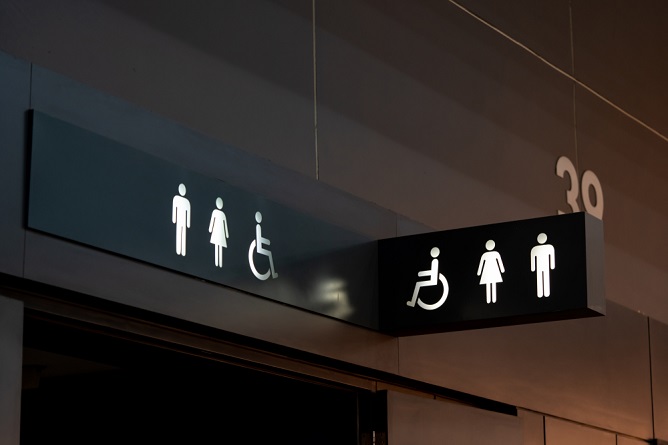Restroom Signage: Enhancing Public Spaces with Clarity and Inclusion
The Role of Restroom Signage in Public Spaces
The significance of well-organized restroom signage cannot be overstated in the dynamic and ever-evolving environments of public places. These signs serve as critical navigational tools that help streamline movement within bustling environments such as airports, shopping malls, and parks. By efficiently directing foot traffic, restroom signage upholds the standards of organization and safety. Restroom signs assist users in locating facilities swiftly, thus contributing positively to their overall experience. Additionally, clear signage is vital for accommodating individuals visiting for the first time or unfamiliar with the area’s layout.
Importance of Clear and Inclusive Signage
Transparent and inclusive signage is indispensable in creating environments that cater to a global audience. Without relying on extensive text, these signs employ universal symbols and, often, braille to convey their messages effectively. Adhering to guidelines such as the ADA Accessible Design Guidelines ensures that signage meets the needs of all users, including those with disabilities. This inclusivity translates into environments where all guests feel acknowledged and respected, enhancing the venue’s reputation and appeal. Signage that factors in diverse needs promotes unquestionable convenience and accessibility.
Evolving Trends in Restroom Sign Design
Design trends have evolved, reflecting broader societal changes towards inclusivity and sustainability. Minimalist designs have gained popularity, with simple yet effective visuals that communicate essential information without overwhelming users. Such clean aesthetics are increasingly favored in modern public spaces. Additionally, the trend of using sustainable materials in restroom signage is on the rise as organizations prioritize environmentally-friendly practices. Furthermore, gender-neutral signs are becoming more prominent, embracing broader inclusivity and acknowledging the fluid nature of gender identities. These designs serve functional purposes and resonate with cultural and social awareness.
The Impact of Technology on Signage Solutions
As technology continues to evolve, its impact on restroom signage solutions has become increasingly significant. Technology is revolutionizing how signage serves the public, from digital displays that offer real-time updates to interactive features that engage and inform users. Modern restroom signs can now feature sensors that detect occupancy levels and offer guidance to less crowded facilities, thereby reducing wait times and enhancing user convenience. Such innovations meet the demand for greater efficiency and improve the overall user experience by providing valuable information at a glance. As technology embeds itself into everyday practicality, users can expect more adaptive and intelligent signage.
Benefits of Accessible Signage for Diverse Groups
The benefits of accessible restroom signage extend to many individuals, including those with mobility challenges, visual impairments, and those who may not be fluent in the local language. Such signage is vital in reducing barriers and ensuring seamless experiences for everyone. Public venues can foster more welcoming and accommodating environments for diverse audiences by prioritizing readability and intuitive design. Venues that are compliant with standards, such as the CDC’s community prevalence findings, contribute positively to inclusivity and demonstrate a commitment to accessibility, which resonates well within the community.
Case Studies: Signage in Modern Public Venues
Examining specific examples of restroom signage implementations offers valuable insights into best practices and successful strategies. Major airports often use signage systems designed to handle large passenger volumes efficiently, ensuring that navigation remains intuitive and stress-free. Similarly, museums incorporate themed signage that complements their exhibits, creating an immersive visitor experience. Shopping centers provide adaptable signage solutions that meet the needs of a diverse clientele, from families with young children to those with limited mobility. These case studies highlight the versatility and creative potential of well-thought-out restroom signage solutions in modern public venues.
Best Practices in Restroom Signage Design
Designing effective restroom signage involves adhering to a set of best practices that emphasize visibility and clarity. Signs should be positioned at appropriate heights and in locations easily visible to people of varying heights and physical abilities. Using high-contrast color schemes improves readability, particularly in low-light conditions. Additionally, adopting universally recognized symbols ensures that signage is straightforward and intuitive. Regular assessments and updates of signage are necessary to maintain compliance with current accessibility standards and to address evolving needs. By committing to these best practices, public venues can significantly enhance visitor navigation and safety.
Future Perspectives on Signage Innovation
Looking to the future, restroom signage is poised to undergo further innovations that promise to redefine its role in public spaces. Emerging technologies could lead to more interactive and responsive signage systems that adapt to real-time user needs. Integrating wayfinding systems with digital interfaces may offer personalized guidance based on individual needs, enhancing user agency and autonomy. Meanwhile, adopting sustainable materials and production techniques will likely become the norm, contributing to a greener and more sustainable future. These advancements in signage innovation reflect the ongoing commitment to improving public spaces and the experiences they provide for all users.




